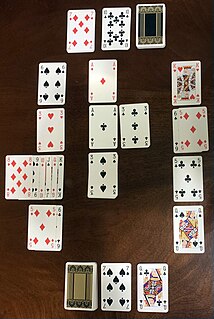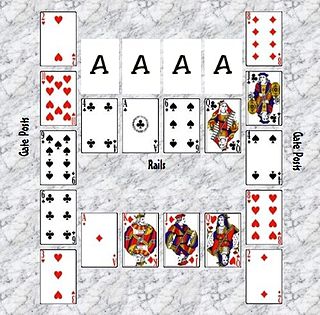Related Research Articles

Games of patience, or (card) solitaires as they are usually called in North America, have their own 'language' of specialised terms such as "building down", "packing", "foundations", "talon" and "tableau". Once learnt they are helpful in describing, succinctly and accurately, how the games are played. Patience games are usually for a single player, although a small number have been designed for two and, in rare cases, three or even four players. They are games of skill or chance or a combination of the two. There are three classes of patience grouped by object.

Klondike, also known as Canfield, is a card game for one player and the best known and most popular version of the patience or solitaire family, something which "defies explanation" as it has one of the lowest rates of success of any such game. Partly because of that, it has spawned numerous variants including Batsford, Easthaven, King Albert, Thumb and Pouch, Somerset or Usk and Whitehead, as well as the American variants of the games, Agnes and Westcliff. The distinguishing feature of all variants is a triangular layout of the tableau, building in ascending sequence and packing in descending order.

Simple Simon is a patience or solitaire card game played with a regular 52 cards deck. It is a close relative of the well-known Spider Solitaire. It became somewhat popular being featured in some computerized collections of Solitaire card games, but its origins possibly predate its implementation as a computerized game.

Russian Bank, Crapette or Tunj, historically also called Wrangle, is a card game for two players from the patience family. It is played with two decks of 52 standard playing cards. The U.S. Playing Card Company, who first published its rules, called it "probably the best game for two players ever invented".
Eight Off is a patience or solitaire card game, named after its employment of eight cells, played with one deck of playing cards. The object of the game is to move all the cards into the foundations. It served as a partial inspiration for and is very similar to the popular solitaire game FreeCell.

Napoleon at St Helena is a 2-deck patience or solitaire card game for one player. It is quite difficult to win, and luck-of-the-draw is a significant factor. The Emperor Napoleon often played patience during his final exile to the island of St Helena, and this is said to be the version he probably played. Along with its variants, it is one of the most popular two-deck patiences or solitaires. The winning chances have been estimated as 1 in 10 games, with success typically dependent on your ability to clear one or more columns. The game is the progenitor of a large family of similar games, mostly with variations designed to make it easier to get out.

Baker's Dozen is a patience or card solitaire using a single pack of fifty-two playing cards. The game is so called because of the 13 columns in the game, the number in a baker's dozen.
Beleaguered Castle is a patience or solitaire card game played with a deck of 52 playing cards. It is sometimes described as "Freecell without cells" because its game play is somewhat akin to the popular solitaire computer game of that name but without extra empty spaces to maneuver. Beleaguered Castle is also called Laying Siege and Sham Battle.
King Albert is a patience or card solitaire using a deck of 52 playing cards of the open packer type. It is a conventional building game, and is said to be named after Albert I of Belgium and is a variant of Somerset. It is the best known of the three games that are each called Idiot's Delight because of the low chance of winning the game.
Royal Cotillion is a solitaire card game which uses two decks of 52 playing cards each. The name probably derives from the fact that since the two kings and two queens of the same suit, the king and queen of each suit dance the cotillion. It has been given the alternate name of Lords and Ladies because if the game is won, the final layout will show the king and queen of each suit together.
Bisley is a patience or card solitaire which uses a deck of 52 playing cards, and while difficult, it often can be completed successfully. It is closely related to Baker's Dozen, but the foundations are built upwards from Ace and downwards from King simultaneously. It is one of the few one-deck games in which the player has options on which foundation a card can be placed.
British Square is a patience or solitaire card game which uses two decks of 52 playing cards each. It is a fan-type game in the style of La Belle Lucie. It has an unusual feature of switchback building whereby each foundation is first built up and then built down.
Martha is a patience or solitaire card game that is played with a deck of 52 playing cards. It has a novelty of having half of the cards in the tableau faced down.
Heads and Tails is a solitaire card game which uses two decks of playing cards. It is mostly based on luck.
Babette is a solitaire card game that uses two decks of playing cards shuffled together, with game play similar to that of the game Labyrinth.
Westcliff is the name of two closely-related patience or card solitaire games of the simple packer type, both of which are played using a deck of 52 playing cards. One version is particularly easy to win, with odds of 9 in 10; the other is harder with odds closer to 1 in 4. The game has a variant, Easthaven.
Fortress is a patience or solitaire card game which is played with a deck of playing cards, in which the entire deck is laid out. It is a member of the Castle family of solitaire games, but has two more tableau piles than Beleaguered Castle and the piles are shorter.
Patriarchs is a patience or card solitaire which is played with two packs of playing cards. It is similar in reserve layout to Odd and Even but with different rules of play.

Gate is a solitaire card game played using a deck of 52 playing cards, and is a member of the Canfield family. It gets its name because the cards are laid out in such a way that they form a gate. Average players can expect to win 99% of their games.

Golf, also known as One Foundation, is a patience or solitaire card game where players try to earn the lowest number of points over the course of nine deals. It has a tableau of 35 face-up cards and a higher ratio of skill to luck than most other solitaire card games. Its easy game-play also makes it within easy reach of first-timers, while still offering scope for strategic play.
References
- ↑ "Tower of Pisa" (p.17) in Card & Dice Games by N.A.C. Bathe, Robert Frederick Ltd, 2004. ISBN 1-889752-06-1
- ↑ "Tower of Pisa" (p.16) in Card Games by John Cornelius, Parragon, 1998. ISBN 1-86309-571-3
- ↑ Lock (1994), pp. 48–49.
- ↑ Coops (1939), p. 110–111.
- ↑ Hervey (1977), pp. 60–61